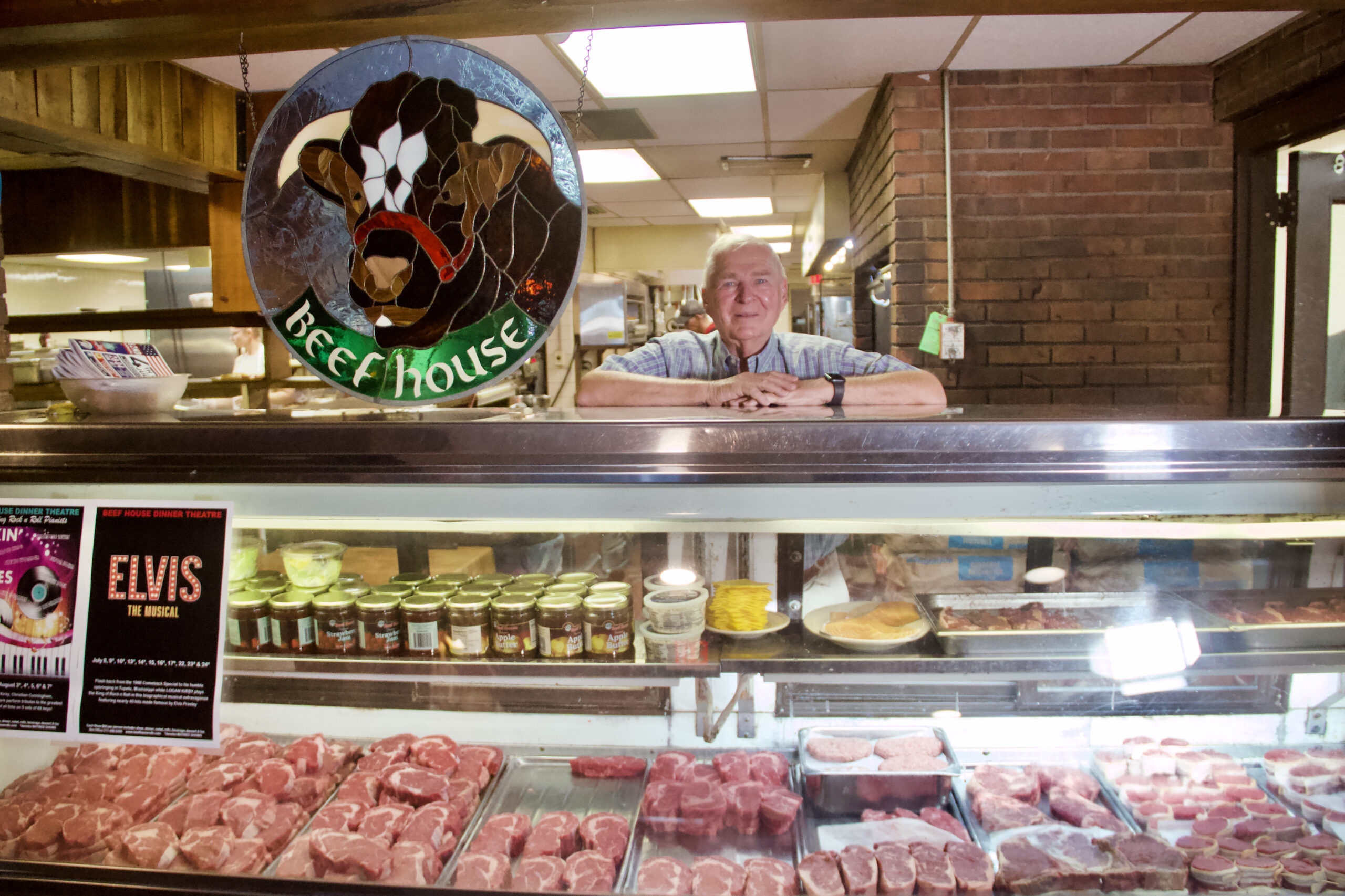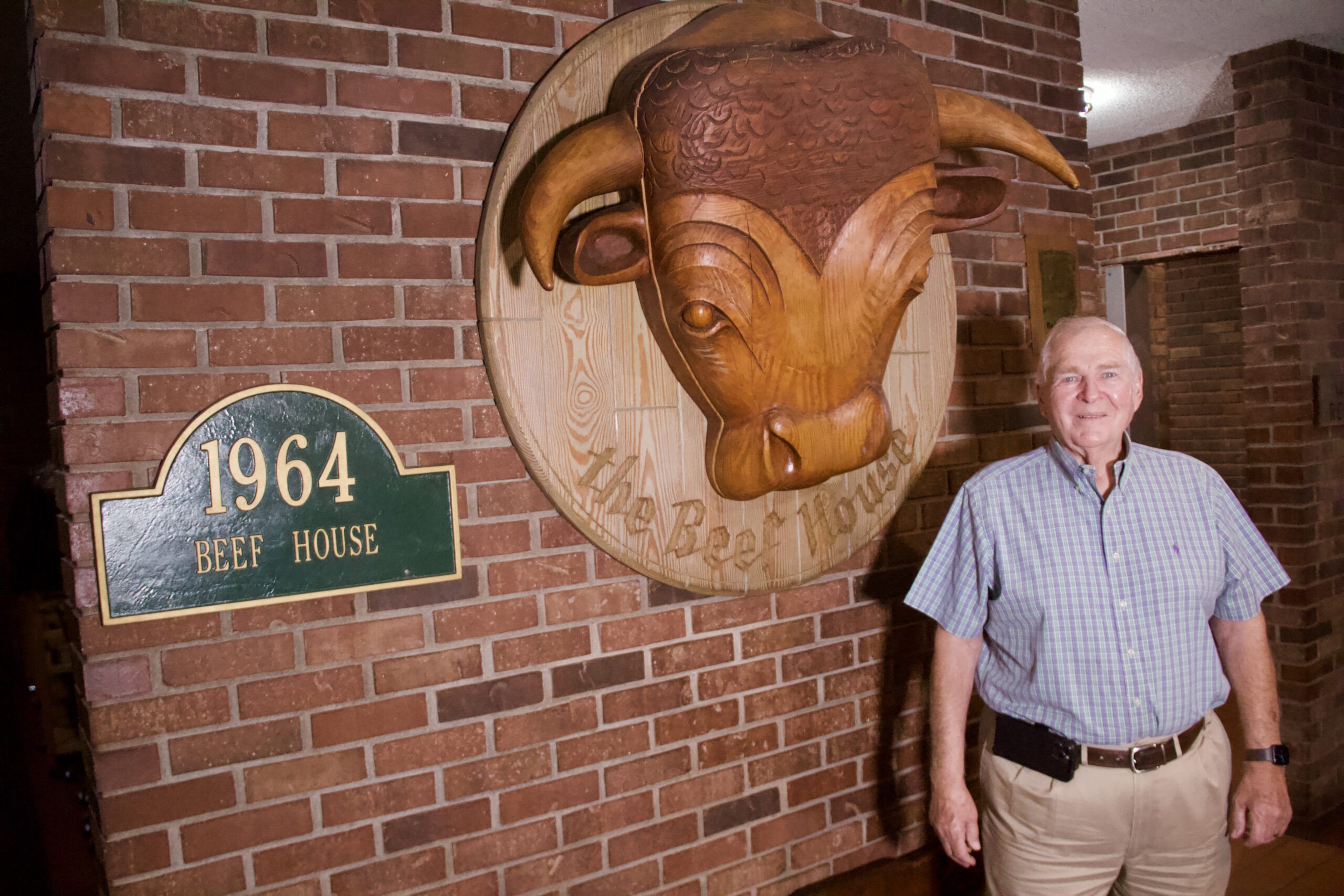Purdue HTM alumnus nears 60 years of serving steaks, rolls in rural Indiana

Robert Wright (HTM ’67) stands behind the Beef House Restaurant’s meat case — a mainstay in the Covington, Indiana, steakhouse. Wright’s parents opened the restaurant in 1964 but he took over soon after his Purdue graduation.Tim Brouk
Written by: Tim Brouk, tbrouk@purdue.edu
Decades before the phrase “farm to table” popped up on restaurants’ menus and marketing plans, Robert Wright and his family were long ahead of the trend with their Beef House Restaurant.
Wright was a farm boy in Warren County when his father, Warren Wright, decided to get into the restaurant business by opening a sandwich shop in Covington, Indiana, about 50 miles southwest of Purdue University.
Young Robert Wright always wanted to go to college, and an initial major in veterinary medicine at Purdue made most sense, as the family farm raised cattle and hogs along with corn, soybeans and wheat. Livestock get sick, and he wanted to know how to treat them. However, the family restaurant started to grow, especially those ribeye sandwiches culled straight from the farm. Wright changed his course of study to what is now hospitality and tourism management within the College of Health and Human Sciences’ White Lodging-J.W. Marriott, Jr. School of Hospitality and Tourism Management (HTM) just as the Beef House concept officially opened in 1964. By then, Ellen Wright, Robert’s mother, joined in and helped shape the restaurant as the house of beef that it is today.
“Another reason (I switched to HTM) was I had three brothers and a sister, and the farm can support only so many,” said Robert Wright, who took over the restaurant from his mother and father soon after his 1967 Purdue graduation. “So, I thought, ‘Well, I’d better find something else to do besides farming,’ and it’s worked out well. I don’t know of anything I would change.”
Today the beef is shipped in from out of state, but many other dishes still showcase ingredients from nearby farms, including the strawberries in the Beef House’s famous jam and apples in the restaurant’s apple butter.
“There’s an orchard just about 15 miles from here and in the fall, we get yellow delicious apples by a 15-gallon crate,” said Wright, who celebrated the Beef House’s 58th year on July 3. “We have a big kettle in the back that we can cook 67 gallons in that, and we do that about every day.”
While the steaks are showcased in a refrigerated display case when hungry customers walk in, which is a tradition started by Warren Wright 60 years ago, the apple butter and jam are to be used for the restaurant’s famous rolls, which originate from Purdue’s former HTM Café, according to Robert Wright.
Roll the rolls story
Students majoring in hospitality and tourism management receive hands-on restaurant experience. Today, most of those students work in Marriott Hall’s Boiler Bistro and Purdue’s fine dining venue, the John Purdue Room. By working in these eateries, students learn kitchen techniques, front of house soft skills and employee management. Prior to Marriott Hall opening in 2011, students put these skills to work in the cafeteria once located in Stone Hall. It was there Wright learned the secrets to perfect dinner rolls in the 1960s.
“There were a couple ladies in there, and they showed me how to make the rolls,” Wright remembered. “My dad said, ‘You did accomplish one thing: You learned how to make our rolls,’ which is what we are famous for right now.”
Wright sells hundreds of rolls a day. On the weekends, he goes through several batches of dough that weigh in at more than 100 pounds each when the ingredients are combined in his trusty industrial mixer.
Timing is everything in life, which includes roll-baking.
“Baking them fresh right before you eat them every day — that’s the secret to any good bread,” Wright said. “There’s a process to it. You have to use good, quality ingredients. We let them raise then bake them right before customers eat them. We don’t like to bake them too far ahead.
“It’s worked well for this restaurant — real well.”
Keeping employees happy
Wright absorbed information from a Stone Hall Cafe manager during his HTM studies. He saw what treating employees with kindness and fairness can do for a restaurant. Running a large restaurant can turn into a circus, but with organization, empathy and understanding, a loyal workforce can be had. And with skilled staff, customers are more apt to return.
Wright’s work and the Beef House’s reputation and good business gained front and back of house staff with centuries of combined experience working the kitchen, dining room and meat-cutting room.
“My biggest job is taking care of my employees. If your employees aren’t happy, your restaurant isn’t going to be happy,” Wright said. “Well, I’ve got employees that have been with me over 50 years. I have waitresses that have been here 40 years. A lot of others have been here 20, 30 years.”
In the HTM program, he learned to lead by example. From cleaning the toilets and washing dishes to baking rolls and grilling steaks, Wright has done it all in his near 60 years at the Beef House.
He’s got beef

Wright stands next to some signage in the Beef House lobby.Tim Brouk
While the rolls get much spotlight, the ribeye steaks are why it’s the Beef House and not the Bread House. The Wright family’s early years in the cattle business is a fond memory for Wright. He remembers helping his father load about 20 heads of cattle in a truck on Sundays and accompanying him to the historic Union Stock Yards in Chicago. There, a buyer on horseback would offer usually 19 or 20 cents per pound for his dad’s cows. The family would then try nearby restaurants in the Windy City. Warren Wright would get ideas for what would eventually become Robert Wright’s Beef House.
As the years passed and the Beef House’s popularity grew, the Stock Yards were closed, and the meat was shipped in from Iowa Beef Producers. Today, it is still shipped in at a clip of 15 cases of ribeyes a week.
After weeks of wet aging, the steaks are hand cut every afternoon and are displayed in the meat case by dinnertime.
“We want people to walk in and see the steaks,” Wright said.
Another trend that the Beef House beat by many years is the open kitchen concept. Warren Wright wanted his customers to see the steaks they selected grilled in front of them. Today, customers can still see, hear and smell those sizzling steaks and burgers on the grill.
Still a family affair
Robert Wright credits his wife, Bonnie Wright, for helping grow the Beef House, too. The couple married the summer before Robert Wright made the jump to HTM. For more than 50 years, the couple worked side-by-side as their restaurant and family grew.
Generations three and four of the Wright family are currently working at the Beef House. His son, Brad Wright, and daughter, Sarah Wright Tanner, play pivotal roles while those pivotal rolls bake. Wright’s grandson, Evan Wright, is the night manager.
“It’s a family business,” Wright said. “You hope it can live on. I’m sure it will.”
Wright’s time in HTM helped get him a quick start as a restauranteur, and 50-plus years later, he’s still ever grateful for his Purdue experience. Along with his HTM studies, Wright took advantage of what Purdue had to offer by taking art appreciation and music classes; attending baseball, basketball and football games and serving in ROTC for two years.
“I enjoyed going to Purdue. You meet a lot of people and learn a lot of things,” Wright recalled.
Discover more from News | College of Health and Human Sciences
Subscribe to get the latest posts sent to your email.